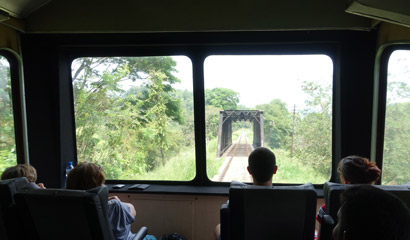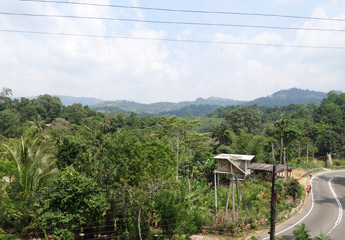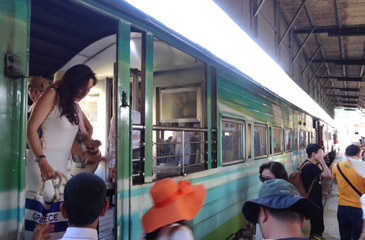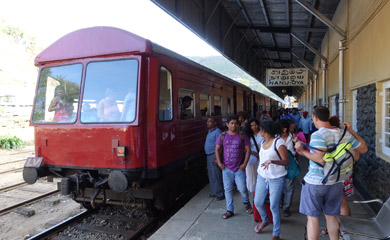| |
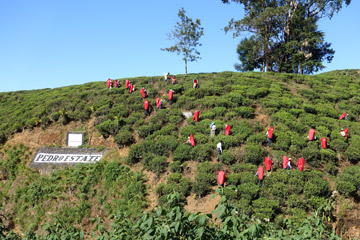 < < |
| |
Tea
pickers on the Pedro Estate, Nuwara Eliya... |
A classic Sri Lankan train
ride...
The train ride from Colombo up
into the tea plantations of central Sri Lanka is a highlight of any trip to Sri
Lanka. You can travel on one of two daily modern
blue trains or as shown here on a classic train
with a first class observation car attached to the rear. This gives a wonderful rearward view along the tracks, you
can see how this wonderful railway was constructed, hugging the hillside under
overhanging rocks. Nanuoya is the
railhead for Nuwara Eliya, a colonial-era hill station where the British would
spend time away from the heat & humidity of the coast, surrounded by Ceylon tea plantations.
 Colombo to Nuwara Eliya in photos
Colombo to Nuwara Eliya in photos
 Watch the video!
Watch the video!
 Nuwara Eliya & a visit to a tea factory
Nuwara Eliya & a visit to a tea factory
Practical information
 Train times &
fares
Train times &
fares
 How to buy tickets
How to buy tickets
 What are the
trains like
What are the
trains like
 Luggage, food & tips
Luggage, food & tips
 |
|
Colombo Fort station,
opened in 1917 in the bustling heart of the old colonial Fort area.
See map. |
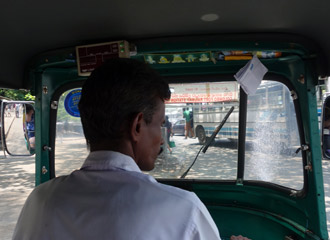 |
|
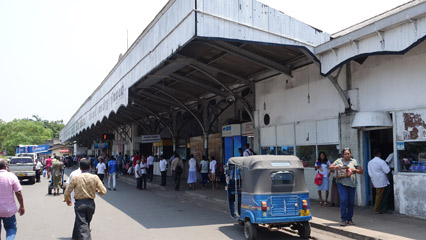 |
|
Arriving at the station by tuk
tuk from the Galle Face
Hotel, the best way to get around cities in Sri Lanka. |
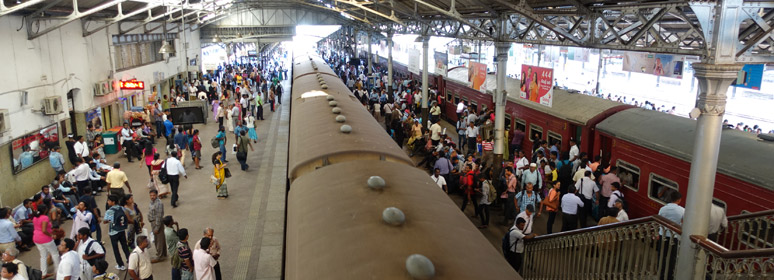 |
|
Bustling Colombo Fort, like a British station in the 1950s
with the heat & humidity turned up... |
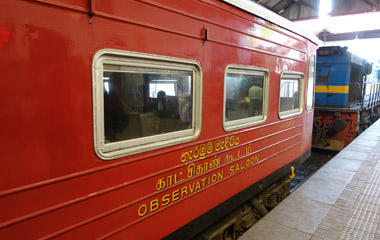 |
|
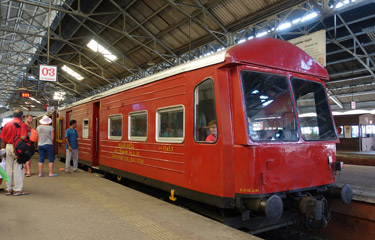 |
|
Boarding the train....
The locomotive draws the train into platform 3, then detaches to run round and
attach to the front. The lucky passengers with first class reservations
for the 09:45 express to Hatton, Nanuoya, Elle & Badulla board the observation
car at the rear. |
 |
|
The train sets off, leaving
Colombo Fort station behind (seen above). Shortly afterwards it trundles
non-stop through Colombo's other main station, Maradana, some 2 km to the east. |
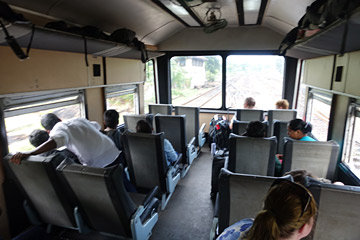 |
|
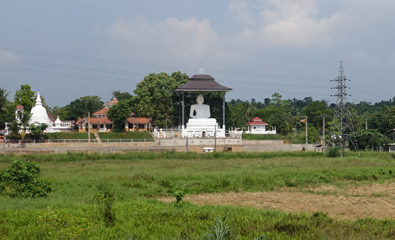 |
|
The observation car is not
air-conditioned, but a breeze wafts in through the open side windows... |
|
Passing a local temple, soon
after leaving Colombo Fort. There's always things to see from a Sri Lankan
train... |
 |
|
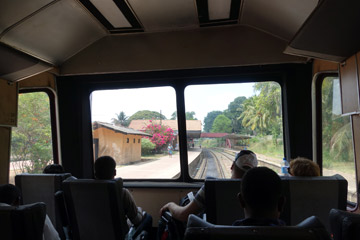 |
|
The train clatters along at 30-50mph, stopping at wayside stations
with neatly-kept flower beds. Above
left, Rambukkana. |
 |
|
The observation car gives a
superb view back along the track, so you can see how this wonderful railway
is constructed. After Rambukkana, where the
Colombo Commuter service ends, the
line is mostly single-track. Sri Lankan railways are built to a broad
gauge, 5' 6", wider than European standard gauge... |
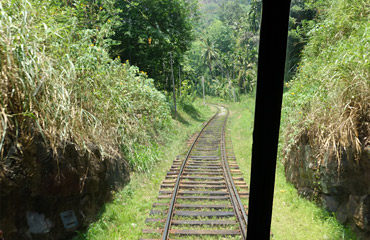 |
|
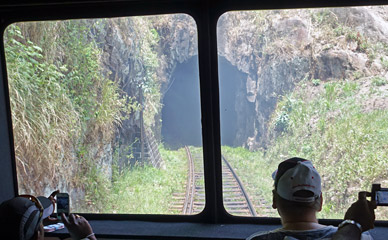 |
|
The line climbs towards Kandy
with tunnels & cuttings gouged from the hillside. In places jungle is reclaiming the tracks... |
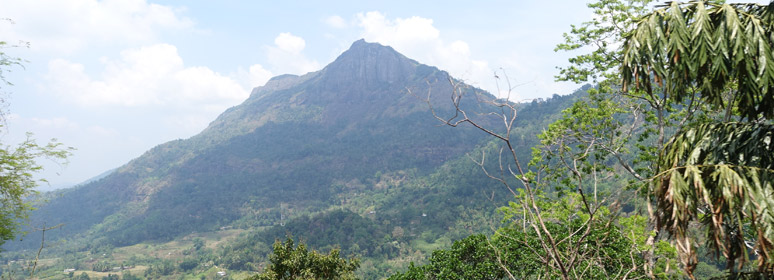 |
|
Mountains from the train... |
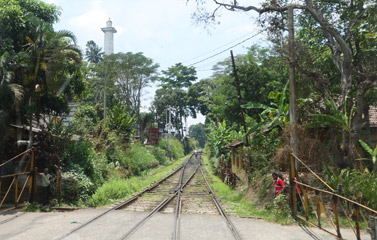 |
|
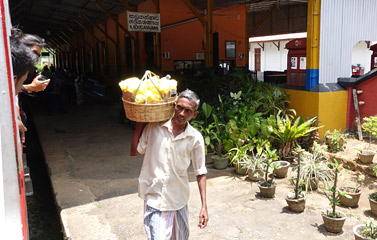 |
|
Kadugannawa... As
the train rolls into Kadugannawa, look for the Dawson Tower on the right (or left as you look rearwards), erected in 1832 in tribute to Royal Engineer
Captain W F Dawson who built much of the adjacent Colombo-Kandy road. |
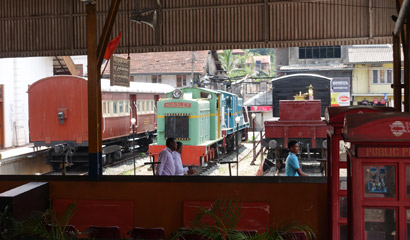 |
|
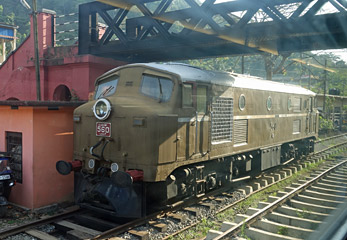 |
|
At Kadugannawa station on the
right (left as you face rearwards) you'll see various exhibits outside Sri
Lanka's National Railway Museum, including this 1953 British-built type M1
(above right). |
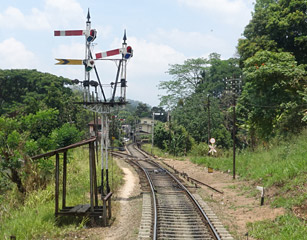 |
|
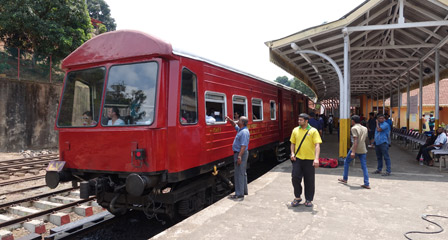 |
|
Peradeniya Junction, near
Kandy...
Sri Lanka's second city is Kandy, located on a 4-mile branch line from
Peradeniya Junction on the Colombo-Badulla main line. The Chinese-built
blue trains turn left at Peradeniya, go into Kandy terminus, change direction,
retrace their steps to Peradeniya and turn left again towards Badulla - they
have a driving cab at each end so it's easy for them. Our classic train
has a locomotive at the front and it by-passes Kandy, picking up passengers from
Kandy at Peradeniya Junction. The station has platforms on all three sides of the
triangular junction, but strangely, the train rolls slowly through the
apparently-disused platform on the side of the triangle that by-passes Kandy,
halts briefly at the signal pictured above left, then it sets back into the
Kandy-to-Hill-country platform. |
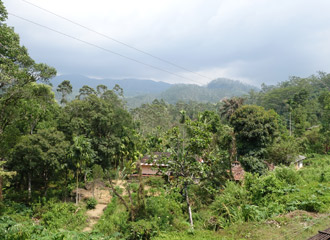 |
|
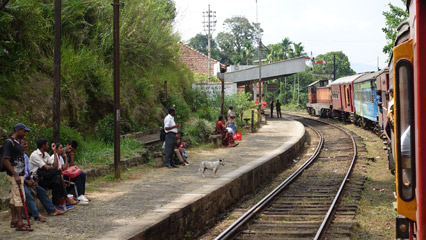 |
|
Galaboda... At the wayside station of Galaboda,
the train waits for the Colombo-bound Podi Menike blue train to pass. |
 |
|
After Galboda, the climb into the
hills continues... |
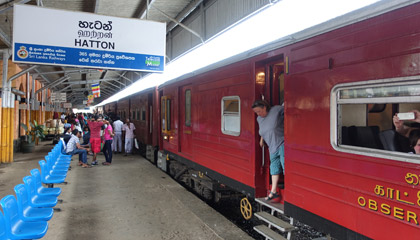 |
|
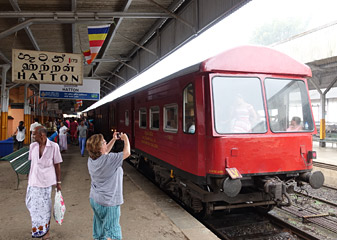 |
|
Hatton, the station for
Adam's Peak...
The train pauses here just long enough for a photo or two. |
 |
|
Tea country! The
train now snakes its way past hills where almost every slope is covered with tea
bushes. |
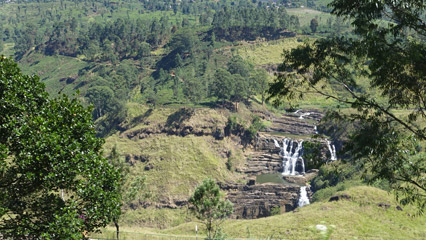 |
|
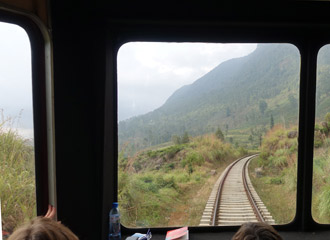 |
|
Waterfall... |
|
|
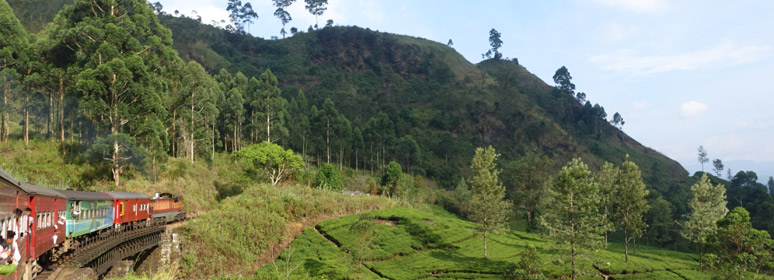 |
|
The weather is changeable, but
the light is now fantastic... |
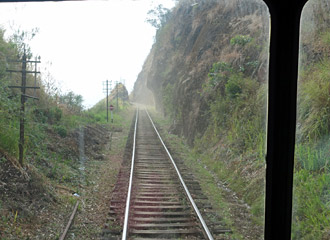 |
|
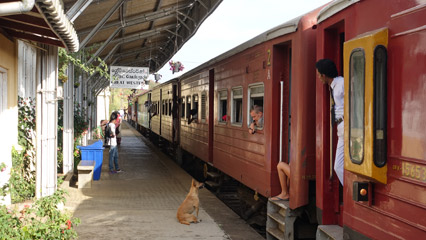 |
|
The line is cut into the
hillside... |
|
A stop at the very
British-sounding Great Western station. |
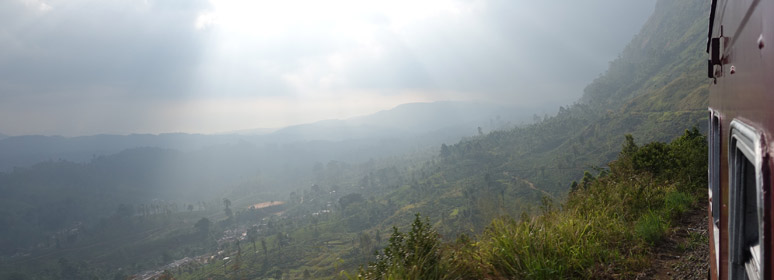 |
|
A rain shower hits the train as
it rattles along above a broad valley... |
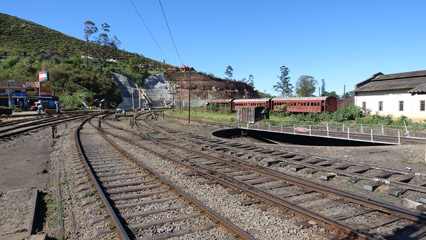 |
|
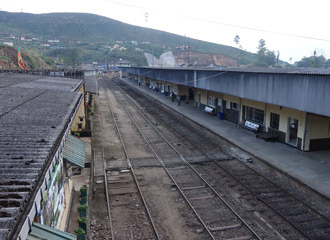 |
|
Nanuoya is the railhead for
Nuwara Eliya, some 7 km away - there are always taxi vans waiting. |
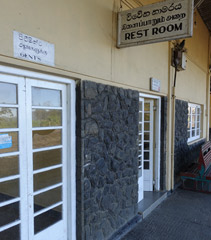 |
|
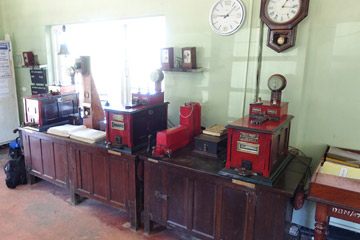 |
|
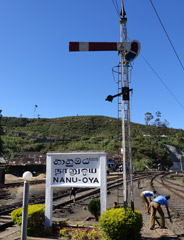 |
|
Rest rooms. You didn't think these
were toilets, did you? Toilets are located nearby. |
|
The ancient British-built tablet
instruments, in the station master's office at Nanuoya. These ensure the
trains run safely on the single line. |
|
Semaphore signal and station
nameboard in the sun at Nanuoya... |
The hill station of Nuwara Eliya is
a strange mix of colonial-era bungalows, modern hotels and guesthouses, a
pleasure lake, parks, and even a racecourse...
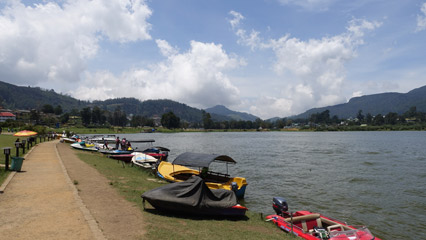 |
|
 |
|
Nuwara Eliya's Gregory Lake... |
|
Nuwara Eliya's colonial era post
office... |
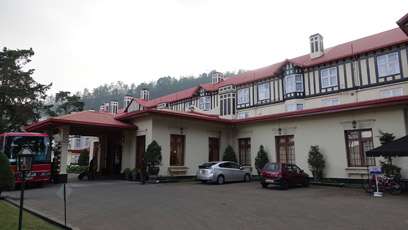 |
|
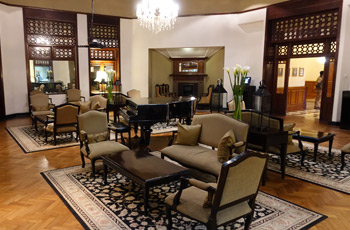 |
|
The best place to stay: Nuwara's
Eliya's historic Grand Hotel built in the style of a Tudor mansion,
check prices & book... |
Time for tea...
You can visit a number of tea
plantations & factories around Nuwara Eliya, including
the Pedro Estate, well worth a visit...
 |
|
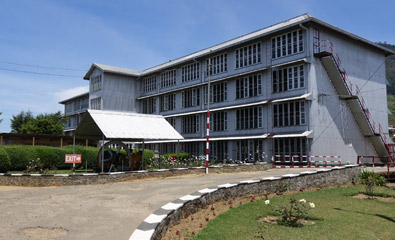 |
|
Tea pickers on the Pedro Estate
at Nuwara Eiya... |
|
The Pedro Estate tea factory... |
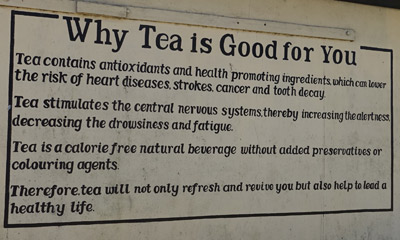 |
|
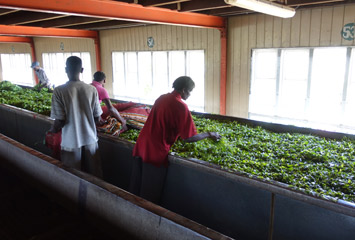 |
|
In case you need reminding... |
|
Drying the tea leaves... |
|
Back to 'Rail travel to Europe' general page
Back to home page
 <
<![]() Colombo to Nuwara Eliya in photos
Colombo to Nuwara Eliya in photos![]() Nuwara Eliya & a visit to a tea factory
Nuwara Eliya & a visit to a tea factory























